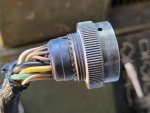My CTIS has been working great for the past 7 years. I’ve been on the road full time in it and using it regularly. I’ve installed a switch on the CTIS harness so I can turn it on or off. I typically turn it on first thing before driving to get all the tires to 85 cold psi just in case any slow leak in the tires, then I shut the CTIS off. A few days ago when the system reached 120 psi I turned on the CTIS and the highway light started blinking like normal then I could hear the normal sounds from the passenger kick panel area and half way through the normal sounds it stopped and all 5 lights started flashing. Repeated this multiple times no change. I then read that is an indication of a large air leak so I removed the output air line port C on the valve body then ran pressurized air to the line with a regulator air a gauge. It held 85 psi for 20 minutes as I listened for air leaks. No leaks found holding pressure. When I removed the pressure from the line one of the dump valves opened up. Reconnect the output air line to port C turned the truck back on got the system back up to 120 psi, turtle CTIS on and now I have Highway and run flat starts flashing, then the first 4 lights start flashing. Turn it off the on 5 lights. Each time I turn it off and on I’m getting different lights flashing. Any suggestions?
Also the test procedure Ron described earlier is would that be a good test for this situation?
The test I described above would be a good next test.
Disconnecting line C and applying regulated air directly to the system is another great way to look for system leaks. You said you connected a line and regulator. Did you shutoff the air supply after you pressurized the system? If the regulated supply was connected it would probably make up for any leaks…
if you pressurized it then closed a valve to remove the supply source and it held for 20 minutes you are probably OK… The dump valves venting briefly is perfectly normal when you disconnect air from that line. the dumps see their input go to zero and make their output go to zero by briefly dumping output side air out the vent. When the wheel valves go below ~5psi, they close and there is no more air left to vent.
connecting air directly to the PCU output line does not however check the PCU for leaks. With the air tanks full, Using the jumpers like I described above, if you put in a jumper between H and R, to close the control solenoid valve and seal the system, then briefly jumper H to B to deliver a shot of supply air to pressurize the system and open the wheel valves, it should also be able to set like that with the system at tire pressure until you pull the H-R jumper or shut off the main switch.
As soon as I do this I immediately get under the truck to see if there is any air coming out of the dump vents. Any air coming out of the dump vents indicates a leak, because as the leak lowers system pressure, the dumps(remote control pressure regulators) will match the decreasing input/system pressure on their output by venting tire air. This would be my same first check if I were applying air directly to the PCU output line(line c in the drawing). Apply air briefly to pressurize the system then close the valve, then check the dump vents. Putting a balloon or rubber glove over the vent port is a good way to monitor for slow leaks that are too small to see or feel.
since you have already tested the main system plumbing minus PCU, and it held pressure, if you detect dump vent air leakage using the jumpers, it is probably the PCU leaking…




